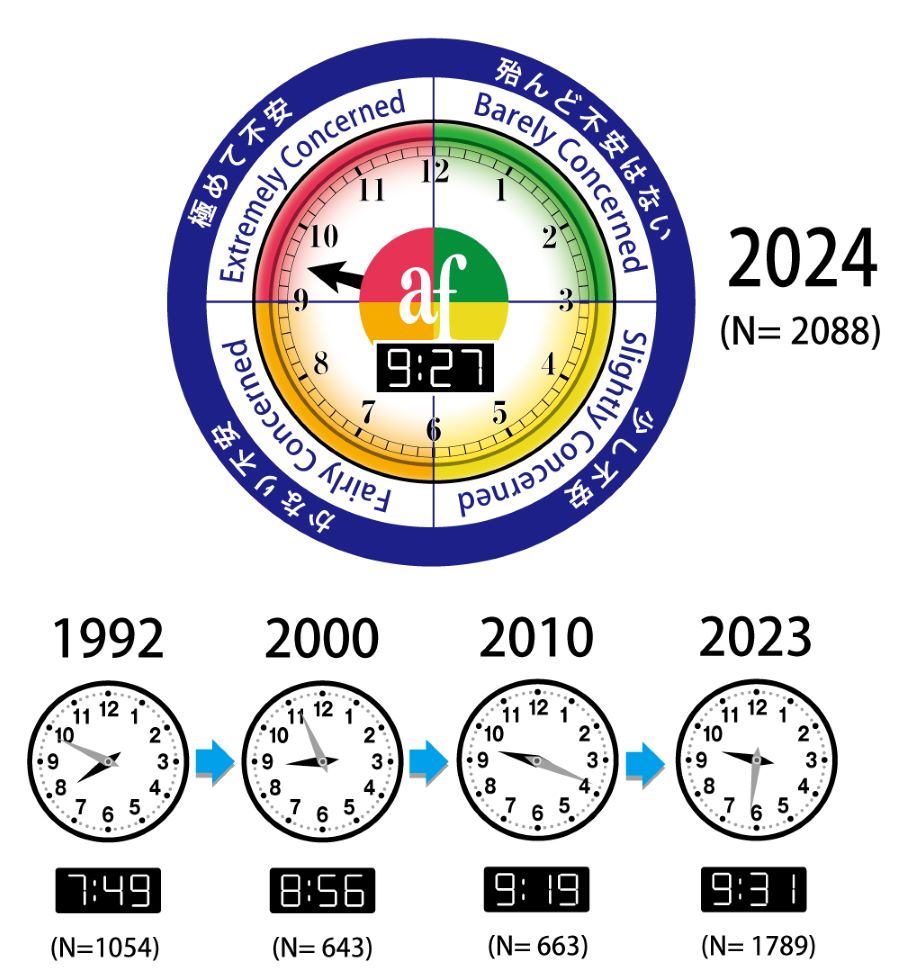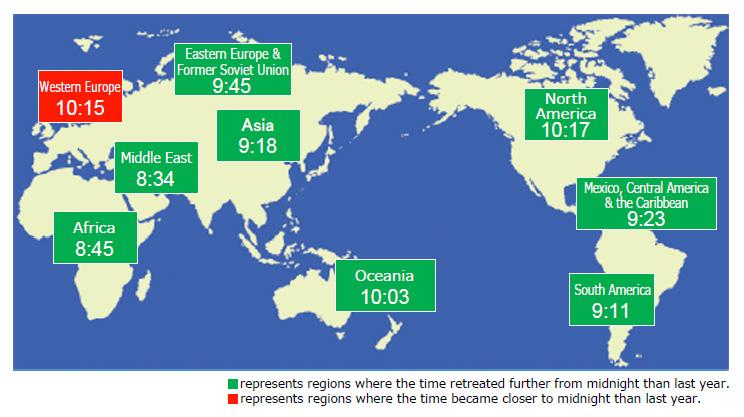The Asahi Glass Foundation Announces the Results of the 33rd Annual “Questionnaire on Environmental Problems and the Survival of Humankind”
The Results of the 33rd Annual “Questionnaire on Environmental Problems and the Survival of Humankind”are available in the report of the “33rd Annual Questionnaire on Environmental Problems and the Survival of Humankind,” or online at the Foundation’s web site,
https://www.af-info.or.jp/en/
The Asahi Glass Foundation (Chairman: Takuya Shimamura) has conducted an annual survey with environmental experts from around the world since 1992. This year, we sent the questionnaire to 202 countries around the world, and received responses from 2,093 people in 128 countries. Below are the main points from this year’s questionnaire results. Further details are available in the report of the “33rd Annual Questionnaire on Environmental Problems and the Survival of Humankind,” or online at the Foundation’s web site, starting at 11 a.m. September 4, 2024.
Summary
・The time on the Environmental Doomsday Clock has gone back for four consecutive years since 2021, striking 9:27 in 2024.
・Looking at the time on the Clock around the world, the time moved forward by 19 minutes in Western Europe compared to last year, but it went back in all other regions.
・”Climate Change” has been the top environmental issue that the respondents worldwide have had on their minds in determining the time on the Clock.
・Relatively few people believe that the conservation and restoration of wildlife habitat is progressing, and it is generally considered to be lagging behind the transition to a decarbonized society.
・With the goal of total achievement of the 17 SDGs by 2030, the average perceived level globally of all SDG achievement as of 2024 was 31%.
・In the respondents’ own country or region, many respondents selected “1. No Poverty,” “10. Reduced Inequalities,” and “13. Climate Action” as the goals that will have the lowest level of realization in 2030.
I. Level of the Crisis Facing Human Survival – The Environmental Doomsday Clock
I-1 The Time on the Environmental Doomsday Clock
・Looking at the time on the Clock around the world, the time moved forward by 19 minutes in Western Europe compared to last year, but it went back in all other regions. In particular, the Clock went back significantly in Mexico, Central America, and the Caribbean (35 minutes); and in the Middle East (44 minutes).
・Regarding the change in the Time on the Environmental Doomsday Clock, since 1996, the time on the clock has consistently remained in the 9 o’clock range, in the “Extremely Concerned” quadrant, with the exception of the year 2000.
I-2 Change in the Time on the Environmental Doomsday Clock by Generation (2014 – 2023)
・The survey respondents aged 60 and over tended to report more advanced times on the Clock than other age groups.
・This year, the time on the Clock moved backward for respondents aged 20 to 50, while it moved forward for those aged 60 and above. This highlights a growing divide in the perception of the current state of environmental issues between younger and older generations.
・Over 80% of Chinese respondents, who are in their 20s and 30s, appear to appreciate the government’s environmental measures and believe that environmental issues in China are heading in a positive direction.
・Approximately 80% of Taiwanese respondents are in their 20s, 30s, or 40s, and they have consistently indicated the time on the Clock to be between 8 and 9 a.m. each year.
II. “Environmental Issues to be Taken into Account” in Determining the Time on the Clock
In determining the time on the Environmental Doomsday Clock, the questionnaire asked respondents to select, from the following nine categories of environmental problems, the three most pressing issues for the country or region where they reside, and rank them in order of importance. (See the Questionnaire Report for further details.)
Nine Environmental Issues to be Taken into Account:
1. Climate Change, 2. Biosphere Integrity (Biodiversity), 3. Land-system Change (Land Use),
4. Biochemical Flows (Pollution/Contamination), 5. Water Resources, 6. Population, 7. Food,
8. Lifestyle (Consumption Habits), 9. Society, Economy and Environment, Policies, Measures
II-1 Weighted Average Selection Percentage of the Nine Environmental Issues
・As in the last year, “Climate Change” (30%) was the most often selected category among the “environmental issues to be taken into account,” which are used to calculate the time on the worldwide Environmental Doomsday Clock. This was followed by “Biosphere Integrity (Biodiversity)” (13%). The percentage of each issue has changed little for over seven years. (Fig. 6)
II-2 Weighted Average Time on the Environmental Doomsday Clock of the Nine Environmental Issues
・When arranging the “environmental issues to be taken into account” for the entire world in order of descending time on the Clock, “Biosphere Integrity (Biodiversity)” (9:59) and “Climate Change” (9:33) were all closer to midnight than the world’s average time of 9:31.
III. Signs of Improvement in the Approach to Environmental Issues: Comparison with the Situation Prior to 2015, When the Paris Agreement and SDGs Were Adopted
Signs of improvement were investigated from the three perspectives, (1) Public Awareness, (2) Policies and Legal System, and (3) Social Infrastructure (Funds, Human Resources, Technologies, and Facilities). We asked, from a list of “Environmental Issues to be Taken into Account,” the respondent’s opinion on whether there have been signs of improvement in the approach to global environmental issues with respect to a decarbonized society and where they saw signs of improvement.
We calculated the average score by quantifying the answers on whether there had been any improvements and giving a score of -2 for the answer “Not improved at all,” -1 for the answer “Somewhat not improved,” 0 for the answer “Cannot say either way,” +1 for the answer “Somewhat improved,” and +2 for the answer “Definitely improved.”
III-1 Progress in a Transition to a Decarbonized Society
・Overall, with regard to transitioning to a decarbonized society, the results show considerably lower scores for three years running in “Policies and Legal System” and “Social Infrastructure (Funds, Human Resources, Technologies, and Facilities)” compared to “Public Awareness.”
III-2 Progress in the Conservation and Restoration of Wildlife Habitats
・Relatively few people believe that the conservation and restoration of wildlife habitat is progressing, and it is generally considered to be lagging behind the transition to a decarbonized society. (Table 2)
・A significant proportion of people in their 20s and 30s hold the view that conservation and restoration of wildlife habitat is making more headway compared to previous generations. (Table 2)
IV Awareness of the 17 Sustainable Development Goals (SDGs)
Regarding the 17 sustainable development goals (SDGs), three goals that will have the highest and lowest level of realization in 2030 were analyzed (multiple-answer question), and the results are shown in Tables 9-1 and 9-2. More detailed data is available in the 2024 annual report of the survey.
・In many countries and regions, “9. Industry, Innovation and Infrastructure,” “4. Quality Education,” and “13. Climate Action” were selected, on average, as goals that will have the highest level of realization in 2030. Though on the downside, a notable number of respondents selected “18. There are no goals with any material level of realization in 2030” (23%).
・In the respondents’ own country or region, “1. No Poverty,” (36%) “10. Reduced Inequalities,” (27%) and “13. Climate Action” (25%) were most commonly selected as goals that will have the lowest level of realization in 2030.
We asked how much progress the respondents think has been made towards achieving the 17 SDGs overall as of 2024, with 100% representing complete achievement of all goals. The numbers were provided from 1 to 100 in increments of 5. Figure 8 shows the distribution of the average perceived level of all SDGs achievement (%) as of 2024.
・Approximately 15% of respondents indicated a perceived level of all SDGs achievement of 0%, 9.5% responded that “No particular progress has been made in achieving the goals,” and the average was 31.0%.
・The 2024 Report (Fig. 18) reveals a significant difference in the perceived level of SDG achievement across generations. Respondents in their 20s and 30s perceive the level of SDG achievement in 2024 to be over 35%, while those aged 50 and over perceive it to be less than 30%.
This survey includes a section where respondents are invited to provide their opinions and write about the environmental realities they face in their region of the world, as well as offer suggestions for improvement. Within the many responses we received from various countries, the respondents provided meaningful opinions and comments. As in previous years, we will post a selection of opinions and comments on the Asahi Glass Foundation website at 11a.m. on September 6, 2023. Please read through the candid opinions of environmental experts.
https://www. af-info.or.jp/en/
●Facts about This Year’s Questionnaire
Survey period: April to June 2023
Respondents:
Environmental experts who work or who have worked for national or local governments, NGOs, NPOs, universities, research institutions, corporations, and mass media, worldwide (listed on the Asahi Glass Foundation database).
Number of questionnaires mailed: approx. 39,000
Number of questionnaires returned: 2.093
Response rate: approx. 5.4%
Contact:
Toshihiro Tanuma, PhD, Director of Commendation Program for the Blue Planet Prize
The Asahi Glass Foundation
2nd Floor, Science Plaza 5-3 Yonbancho Chiyoda-ku Tokyo 102-0081, Japan
Phone: +81-3-5275-0620 Fax: +81-3-5275-0871 e-mail: post@af-info.or.jp URL: https://www.af-info.or.jp
Photos (From the left):
1. The Environmental Doomsday Clock 2024
2. Regional Times on the Environmental Doomsday Clock




